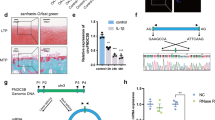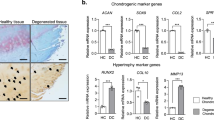Abstract
Many tissues have a specific signal transduction system for endoplasmic reticulum (ER) dysfunction; however, the mechanisms underlying the ER stress response in cartilage remain unclear. BBF2H7 (BBF2 human homologue on chromosome 7), an ER-resident basic leucine zipper transcription factor, is activated in response to ER stress1 and is highly expressed in chondrocytes. In this study, we generated Bbf2h7−/− mice to assess the in vivo function of BBF2H7. The mice showed severe chondrodysplasia and died by suffocation shortly after birth because of an immature chest cavity. The cartilage showed a lack of typical columnar structure in the proliferating zone and a decrease in the size of the hypertrophic zone, resulting in a significant reduction of extracellular matrix proteins. Interestingly, proliferating chondrocytes showed abnormally expanded ER, containing aggregated type II collagen (Col2) and cartilage oligomeric matrix protein (COMP). We identified Sec23a, which encodes a coat protein complex II component responsible for protein transport from the ER to the Golgi2,3, as a target of BBF2H7, which directly bound to a CRE-like sequence in the promoter region of Sec23a to activate its transcription. When Sec23a was introduced to Bbf2h7−/− chondrocytes, the impaired transport and secretion of cartilage matrix proteins was totally restored, indicating that by activating protein secretion the BBF2H7–Sec23a pathway has a crucial role in chondrogenesis. Our findings provide a new link by which ER stress is converted to signalling for the activation of ER-to-Golgi trafficking.
This is a preview of subscription content, access via your institution
Access options
Subscribe to this journal
Receive 12 print issues and online access
$209.00 per year
only $17.42 per issue
Buy this article
- Purchase on Springer Link
- Instant access to full article PDF
Prices may be subject to local taxes which are calculated during checkout





Similar content being viewed by others
Accession codes
References
Kondo, S. et al. BBF2H7, a novel transmembrane bZIP transcription factor, is a new type of endoplasmic reticulum stress transducer. Mol. Cell. Biol. 27, 1716–1729 (2007).
Paccaud, J. P. et al. Cloning and functional characterization of mammalian homologues of the COPII component Sec23. Mol. Biol. Cell 7, 1535–1546 (1996).
Fromme, J. C., Orci, L. & Schekman, R. Coordination of COPII vesicle trafficking by Sec23. Trends Cell Biol. 98, 330–336 (2008).
Ron, D. Translational control in the endoplasmic reticulum stress response. J. Clin. Invest. 110, 1383–1388 (2002).
Schroder, M. & Kaufman, R. J. ER stress and the unfolded protein response. Mutat. Res. 569, 29–63 (2005).
Kondo, S. et al. OASIS, a CREB/ATF-family member, modulates UPR signalling in astrocytes. Nature Cell Biol. 7, 186–194 (2005).
Murakami, T. et al. Cleavage of the membrane-bound transcription factor OASIS in response to endoplasmic reticulum stress. J. Neurochem. 96, 1090–1100 (2006).
Omori, Y. et al. CREB-H: a novel mammalian transcription factor belonging to the CREB/ATF family and functioning via the box-B element with a liver-specific expression. Nucleic Acids Res. 29, 2154–2162 (2001).
Zhang, K. et al. Endoplasmic reticulum stress activates cleavage of CREBH to induce a systemic inflammatory response. Cell 124, 587–599 (2006).
Adham, I. M. et al. Reduction of spermatogenesis but not fertility in Creb3l4-deficient mice. Mol. Cell. Biol. 25, 7657–7664 (2005).
Nagamori, I. et al. The testes-specific bZip type transcription factor Tisp40 plays a role in ER stress responses and chromatin packaging during spermiogenesis. Genes Cells 11, 1161–1171 (2006).
Lu, R., Yang, P., O'Hare, P. & Misra, V. Luman, a new member of the CREB/ATF family, binds to herpes simplex virus VP16-associated host cellular factor. Mol. Cell. Biol. 17, 5117–5126 (1997).
Chen, Q., Johnson, D. M., Haudenschild, D. R. & Goetinck, P. F. Progression and recapitulation of the chondrocyte differentiation program: cartilage matrix protein is a marker for cartilage maturation. Dev. Biol. 172, 293–306 (1995).
Kronenberg, H. M. Developmental regulation of the growth plate. Nature 423, 332–336 (2003).
Cremer, M. A., Rosloniec, E. F. & Kang, A. H. The cartilage collagens: a review of their structure, organization, and role in the pathogenesis of experimental arthritis in animals and in human rheumatic disease. J. Mol. Med. 76, 275–288 (1998).
Oldberg, A., Antonsson, P., Lindblom, K. and Heinegård, D. COMP (cartilage oligomeric matrix protein) is structurally related to the thrombospondins. J. Biol. Chem. 267, 22346–22350 (1992).
Terpstra, L. et al. Reduced chondrocyte proliferation and chondrodysplasia in mice lacking the integrin-linked kinase in chondrocytes. J. Cell Biol. 162, 139–148 (2003).
Bengtsson, T. et al. Loss of alpha10beta1 integrin expression leads to moderate dysfunction of growth plate chondrocytes. J. Cell Sci. 118, 929–936 (2005).
Bi, W., Deng, J. M., Zhang, Z., Behringer, R. R. & de Crombrugghe, B. Sox9 is required for cartilage formation. Nature Genet. 22, 85–89 (1999).
Boyadjiev, S. A. et al. Cranio-lenticulo-sutural dysplasia is caused by a SEC23A mutation leading to abnormal endoplasmic-reticulum-to-Golgi trafficking. Nature Genet. 38, 1192–1197 (2006).
Fromme, J. C. et al. The genetic basis of a craniofacial disease provides insight into COPII coat assembly. Dev. Cell 13, 623–634 (2007).
Muramatsu, S. et al. Functional gene screening system identified TRPV4 as a regulator of chondrogenic differentiation. J. Biol. Chem. 282, 32158–32167 (2007).
Woods, A., Khan, S. & Beier, F. C-type natriuretic peptide regulates cellular condensation and glycosaminoglycan synthesis during chondrogenesis. Endocrinology 148, 5030–5041 (2007).
Hata, K. et al. Paraspeckle protein p54nrb links Sox9-mediated transcription with RNA processing during chondrogenesis in mice. J. Clin. Invest. 118, 3098–3108 (2008).
Heather, P. et al. Diabetes mellitus and exocrine pancreatic dysfunction in perk-/- mice reveals a role for translational control in secretory cell survival. Mol. Cell 7, 1153–1163 (2001).
Imai, Y. et al. An unfolded putative transmembrane polypeptide, which can lead to endoplasmic reticulum stress, is a substrate of Parkin. Cell 105, 891–902 (2001).
Acknowledgements
We thank M. Tohyama and S. Shiosaka for helpful discussions and critical reading of the manuscript, and K. Ogawa, A. Ikeda, I. Tsuchimochi, T. Kawanami, A. Kawai and Y. Koreeda for technical support. This work was partly supported by grants from the Japan Society for the Promotion of Science KAKENHI (#19659082, #20059028, #19790238 and #20-3757) and The Novartis Foundation (Japan) for the Promotion of Science.
Author information
Authors and Affiliations
Contributions
A.S. and K.I. designed experiments. A.S., S.H., T.M., S.Ka and S.Ko performed experiments. M.S., R.N., T.Y., T.F. and S.I. guided cartilage experiments. S.H., M.I. and M.O. generated Bbf2h7−/− mice. R.N., T.Y., S.I. and M.O. helped write the manuscript. A.S. and K.I. wrote the manuscript. K.I. supervised the project.
Corresponding author
Ethics declarations
Competing interests
The authors declare no competing financial interests.
Supplementary information
Supplementary Information
Supplementary Information (PDF 1626 kb)
Rights and permissions
About this article
Cite this article
Saito, A., Hino, Si., Murakami, T. et al. Regulation of endoplasmic reticulum stress response by a BBF2H7-mediated Sec23a pathway is essential for chondrogenesis. Nat Cell Biol 11, 1197–1204 (2009). https://doi.org/10.1038/ncb1962
Received:
Accepted:
Published:
Issue Date:
DOI: https://doi.org/10.1038/ncb1962
This article is cited by
-
Atypical cell death and insufficient matrix organization in long-bone growth plates from Tric-b-knockout mice
Cell Death & Disease (2023)
-
NMP4, an Arbiter of Bone Cell Secretory Capacity and Regulator of Skeletal Response to PTH Therapy
Calcified Tissue International (2023)
-
Sec23a inhibits the self-renewal of melanoma cancer stem cells via inactivation of ER-phagy
Cell Communication and Signaling (2022)
-
MBTPS2, a membrane bound protease, underlying several distinct skin and bone disorders
Journal of Translational Medicine (2021)
-
Single-cell analysis reveals androgen receptor regulates the ER-to-Golgi trafficking pathway with CREB3L2 to drive prostate cancer progression
Oncogene (2021)



